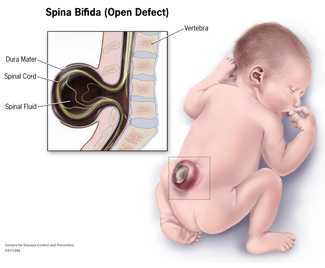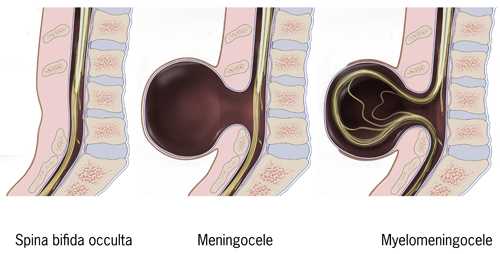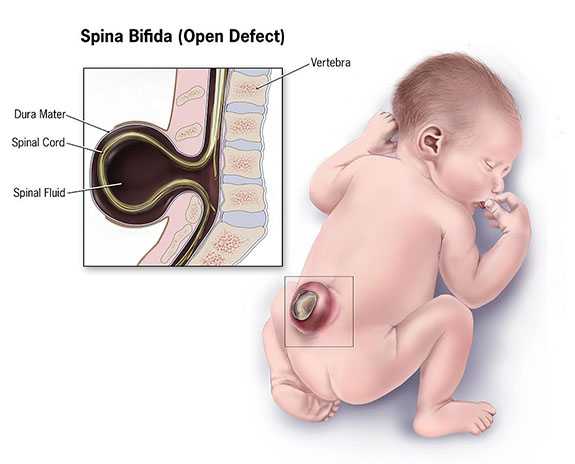Basics

Spina bifida is a condition that affects the spine and is usually apparent at birth. It is a type of neural tube defect (NTD).
Spina bifida can happen anywhere along the spine if the neural tube does not close all the way. When the neural tube doesn’t close all the way, the backbone that protects the spinal cord doesn’t form and close as it should. This often results in damage to the spinal cord and nerves.
Spina bifida might cause physical and intellectual disabilities that range from mild to severe. The severity depends on:
- The size and location of the opening in the spine.
- Whether part of the spinal cord and nerves are affected.
The three most common types of spina bifida are:
Myelomeningocele (sounds like: my-low-ma-nin-jo-seal; hear how “myelomeningocele” sounds)
When people talk about spina bifida, most often they are referring to myelomeningocele. Myelomeningocele is the most serious type of spina bifida. With this condition, a sac of fluid comes through an opening in the baby’s back. Part of the spinal cord and nerves are in this sac and are damaged. This type of spina bifida causes moderate to severe disabilities, such as problems affecting how the person goes to the bathroom, loss of feeling in the person’s legs or feet, and not being able to move the legs.
Meningocele (sounds like: ma-nin-jo-seal; hear how “meningocele” sounds)
Another type of spina bifida is meningocele. With meningocele a sac of fluid comes through an opening in the baby’s back. But, the spinal cord is not in this sac. There is usually little or no nerve damage. This type of spina bifida can cause minor disabilities.
Spina Bifida Occulta (sounds like: o-cult-tuh; hear how “occulta” sounds)
Spina bifida occulta is the mildest type of spina bifida. It is sometimes called “hidden” spina bifida. With it, there is a small gap in the spine, but no opening or sac on the back. The spinal cord and the nerves usually are normal. Many times, spina bifida occulta is not discovered until late childhood or adulthood. This type of spina bifida usually does not cause any disabilities.
Spina bifida can be diagnosed during pregnancy or after the baby is born. Spina bifida occulta might not be diagnosed until late childhood or adulthood, or might never be diagnosed.
During Pregnancy
During pregnancy there are screening tests (prenatal tests) to check for spina bifida and other birth defects. Talk with your doctor about any questions or concerns you have about this prenatal testing.
- AFP – AFP stands for alpha-fetoprotein (sounds like: al-fa–fee-toe-pro-teen), a protein the unborn baby produces. This is a simple blood test that measures how much AFP has passed into the mother’s bloodstream from the baby. A high level of AFP might mean that the baby has spina bifida. An AFP test might be part of a test called the “triple screen” that looks for neural tube defects and other issues.
- Ultrasound – An ultrasound is a type of picture of the baby. In some cases, the doctor can see if the baby has spina bifida or find other reasons that there might be a high level of AFP. Frequently, spina bifida can be seen with this test.
- Amniocentesis (sounds like: am-knee-oh-sin-te-sus; hear how “amniocentesis” sounds) – For this test, the doctor takes a small sample of the amniotic fluid surrounding the baby in the womb. Higher than average levels of AFP in the fluid might mean that the baby has spina bifida.
After the Baby Is Born
In some cases, spina bifida might not be diagnosed until after the baby is born.
Sometimes there is a hairy patch of skin or a dimple on the baby’s back that is first seen after the baby is born. A doctor can use an image scan, such as an, X-ray, MRI, or CT, to get a clearer view of the baby’s spine and the bones in the back.
Sometimes spina bifida is not diagnosed until after the baby is born because the mother did not receive prenatal care or an ultrasound did not show clear pictures of the affected part of the spine.
Not all people born with spina bifida have the same needs, so treatment will be different for each person. Some people have problems that are more serious than others. People with myelomeningocele and meningocele will need more treatments than people with spina bifida occulta.
To learn more about treatments, visit the Treatments page.
We do not know all of the causes of spina bifida. The role that genetics and the environment play in causing spina bifida needs to be studied further.
However, we do know that there are ways for women to reduce the risk of having a baby with spina bifida both before and during her pregnancy.
If you are pregnant or could get pregnant, use the following tips to help prevent your baby from having spina bifida:
- Take 400 micrograms (mcg) of folic acid every day. If you have already had a pregnancy affected by spina bifida, you may need to take a higher dose of folic acid before pregnancy and during early pregnancy. Talk to your doctor to discuss what’s best for you.
- Talk to your doctor or pharmacist about any prescription and over-the-counter drugs, vitamins, and dietary or herbal supplements you are taking. Learn about medication and pregnancy »
- If you have a medical condition―such as diabetes or obesity―be sure it is under control before you become pregnant.
- Avoid overheating your body, as might happen if you use a hot tub or sauna.
- Treat any fever you have right away with Tylenol® (or store brand acetaminophen).
Remember!
Spina bifida happens in the first few weeks of pregnancy, often before a woman knows she’s pregnant. Although folic acid is not a guarantee that a woman will have a healthy pregnancy, taking folic acid can help reduce a woman’s risk of having a pregnancy affected by spina bifida. Because half of all pregnancies in the United States are unplanned, it is important that all women who can become pregnant take 400 mcg of folic acid daily one month before pregnancy and during early pregnancy.
Spina bifida can range from mild to severe. Some people may have little to no disability. Other people may be limited in the way they move or function. Some people may even be paralyzed or unable to walk or move parts of their body.
Even so, with the right care, most people affected by spina bifida lead full, productive lives.
- Page last reviewed: September 11, 2017
- Page last updated: October 17, 2016
- Content source:


 ShareCompartir
ShareCompartir

